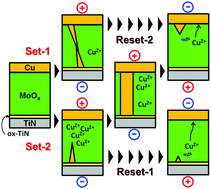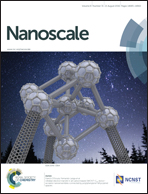Microstructural transitions in resistive random access memory composed of molybdenum oxide with copper during switching cycles†
Abstract
The switching operation of a Cu/MoOx/TiN resistive random access memory (ReRAM) device was investigated using in situ transmission electron microscopy (TEM), where the TiN surface was slightly oxidized (ox-TiN). The relationship between the switching properties and the dynamics of the ReRAM microstructure was confirmed experimentally. The growth and/or shrinkage of the conductive filament (CF) can be classified into two set modes and two reset modes. These switching modes depend on the device's switching history, factors such as the amount of Cu inclusions in the MoOx layer and the CF geometry. High currents are needed to produce an observable change in the CF. However, sharp and stable switching behaviour can be achieved without requiring such a major change. The local region around the CF is thought to contribute to the ReRAM switching process.

- This article is part of the themed collection: Electrochemical processes at the nanoscale: from fundamentals to applications

 Please wait while we load your content...
Please wait while we load your content...